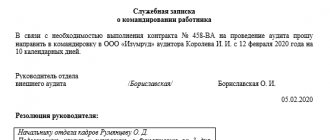The Regulations on Personnel Adaptation are a document that helps simplify the process of entering a position and distribute the areas of responsibility of the immediate manager and the personnel management service related to the hiring of an employee.
With proper design and familiarization of all people involved in this process, the company quickly receives results from the work of the newcomer. Let's look at the key points that need to be included in the document.
Goals and objectives of personnel adaptation in the organization
Organizing the management of career guidance and personnel adaptation is, first of all, the work of the personnel department, as well as the head of the department where the new employee works.
Adaptation is an important point in personnel management, which determines which personnel will work in the organization, what the psychological climate in the team will be, and how well and productively employees will perform their duties.
https://www.youtube.com/watch?v=ytaboutru
The goals of the work on adaptation of new employees are:
- accelerating the process of introducing a new employee to the job, familiarizing him with his job responsibilities;
- complete elimination or reduction of staff turnover in the organization;
- motivating employees to be interested in the result, to be motivated to perform their job duties better, and to give maximum return to their work;
- increase in labor productivity;
- improving the psychological climate in the team.
Only taking into account all the listed factors and working in this direction will give the best result.
Stages of personnel adaptation
Adaptation of personnel at an enterprise is a delicate and multi-stage process. Each organization has its own program and its own developed approaches to solving this issue.
But in general, all possible stages of personnel adaptation can be divided into:
- Primary (preparatory). After hiring a new employee, the manager introduces him to the rest of the team. Introduces the employee himself to his new workplace, appoints a curator (a more experienced employee who will help the newcomer at the beginning of work), and completes the preparation of all necessary documents. This stage may also include familiarization with the history of the enterprise, its structure, mission, products, procedures, and rules of corporate ethics.
- Theoretical (training). At this stage, the employee is introduced to the theoretical part of his main job, functional responsibilities and requirements for further work performance.
- Practical (application of knowledge). Directly performing some practical tasks: first under the supervision of a mentor, then independently.
- Final (passing the probationary period). It consists of summing up the work of the new employee. It is assessed how successfully he settled into the new team, managed to master new skills, and integrated into the team. At this stage, the employee’s strengths and weaknesses, his successes and failures are already visible. Based on everything taken together, management makes a decision on its future fate. Whether he passed the test and will continue to work or not, and the company no longer needs his services.
Based on the foregoing, one can understand how labor adaptation of personnel is an important and serious thing, and that this is one of the indicators on the basis of which a decision is made whether the applicant will remain in the organization or will look for work elsewhere.
Personnel adaptation methods
The research program for the personnel adaptation system identifies the following forms of personnel adaptation:
- mentoring (providing assistance at the initial stage of work by a more experienced employee through consulting, introduction, assistance in getting to know the team);
- attending trainings and seminars (training and developing certain employee skills, for example, communication, public speaking skills, preparing presentations, developing stress resistance, etc.);
- conversation (an introductory conversation between a newcomer and a HR manager, supervisor, or HR department employee, during which the employee receives answers to his questions);
- a specialized program (for example, educational films or team role-playing games aimed at team building);
- excursion (sightseeing tour of the organization, its structural divisions, territory, familiarization with the history of the company, employees, corporate culture);
- request for feedback (at the end of the period of adaptation and completion of the probationary period, the employee is asked to fill out a feedback questionnaire);
- other methods (corporate events, certification, testing, training, etc.).
Responsible for adaptation
An employee of the personnel (labor) department, management service, personnel training, HR service, sociological laboratory, training center (personnel retraining), the immediate superior, the head of a structural unit (department, workshop, bureau, group, service) may be responsible for the adaptation of an employee. Head of the organization.
Large companies are introducing into the staffing table the position of adaptation manager (mentor), responsible for recruiting personnel, comfortable entry of a newcomer into the team, preparation and training.
Responsibility for a newcomer is often borne by a mentor; a curator is a highly qualified employee with extensive work experience, teaching abilities, and is respected in the team.
What does the adaptation program consist of?
Several templates of assistance are included in the provision on adaptation of newly hired employees, depending on who is hired:
- manager;
- administration employees;
- workers.
It is also necessary to separate adaptation algorithms for employees who have practical experience in similar or functionally similar positions, and those who came to their first job after receiving professional education.
As a rule, recent graduates do not know how to apply their skills in practice; their knowledge is theoretical. Completing an internship at a future place of work helps to reduce the adaptation period to some extent.
The manager's adaptation pattern will also depend on whether he came from outside or promoted an experienced employee from one of the departments. In the first case, the boss needs additional time to familiarize himself with his subordinates and the specific features of the activities of the unit he will lead.
For a company employee who has received a promotion, adaptation will consist largely of psychological “grinding in” between subordinates and the new manager, since he has already learned the activities of the department or service in the process of working as a specialist. It may be necessary to obtain any additional knowledge in related areas of the company's activities.
https://www.youtube.com/watch?v=ytpressru
We invite you to familiarize yourself with: The procedure and rules for dismissal by agreement of the parties in accordance with the provisions of the Labor Code of the Russian Federation
Administrative staff, supply and marketing employees are familiarized with job responsibilities and the specifics of work in a specific market segment occupied by the company or its counterparties.
Workers are taught how to handle equipment if they have worked on other mechanisms and units. They show how to carry out the production process and increase the efficiency of their work.
An employee adaptation program is a plan for introducing an employee to a position. This document is needed to apply a uniform approach to the adaptation procedure across departments of the organization. The document is an extensive list of actions for the adapting employee and for his supervisor, who will help adapt to new working conditions.
For an employee, the most difficult period is the first two to three months, which usually coincide with his probationary period. Often the duration of the program is equal in length to this period.
An optimally formed program is characterized by the following features:
- clear planning;
- clear content;
- strict distribution of roles and tasks.
The document can consist of two parts: general and individual.
1. The general part, which helps to form a general idea of the enterprise, its features, hierarchy, established relationships between departments, distribution of functionality, working conditions, etc.
Comprises:
- orientation introductory conversation;
- personal acquaintance with the enterprise and personnel;
- getting to know the place where work duties are performed;
- orientation conversation with the manager heading the structural unit.
2. The individual part, which is formed by the immediate supervisor who supervises the induction of the employee. It is agreed upon with the head of the area of activity and the head of the HR department. This component helps the employee obtain detailed information about the activities of the organization, as well as the direct functional responsibilities of the employee.
Comprises:
- inauguration plan;
- entry assessment plan;
- definitions of a curator-mentor;
- employee report on the results of work performed, information about ratings and feedback from mentors and supervisors.
SOWY.RU
TERMS AND DEFINITIONS
Personnel selection is an activity to attract specialists to vacant positions at Stroymontazh Corporation (hereinafter referred to as the Company).
External selection – attracting specialists to vacant positions from the external labor market.
Internal selection – attracting specialists to vacant positions using the Company’s internal resources, including from the personnel reserve, on the basis of a competition to fill a vacant position.
Personnel reserve - Company employees who have the skills or the potential to develop the skills necessary to fill a vacant position.
1. GENERAL PRINCIPLES
1.1. The Company carries out both external and internal personnel selection.
1.2. Personnel selection is carried out on the basis of the forecast of the personnel situation recorded in the Company’s staffing table.
1.3. Personnel selection is carried out according to approved selection procedures.
1.4. The pace of personnel selection is regulated by the schedule for filling vacancies.
1.5. When a vacant position is put up for competition, all other things being equal, preference is given to the Company's personnel reserve.
1.6. Recruitment activities are carried out by the Personnel Management Service.
1.7. External personnel selection can be carried out with the involvement of: the media, personnel and recruiting agencies, recommendations of Company employees.
1.8. Selection is carried out only for positions approved in the Company’s staffing table.
1.9. The creation of a staffing table is regulated by presidential decree.
2. SELECTION REGULATIONS
2.1. In the event of a vacancy, a Manager at least at the level of the Head of a structural unit (hereinafter referred to as the Customer) submits to the Selection Manager an Application for the selection of a specialist (Appendix 1). The application is submitted in writing or by email from the Customer’s personal mailbox.
2.2. The selection manager accepts only applications for production:
- corresponding to the approved staffing table;
- having an accurate and as complete description of the vacancy as possible.
2.3. The selection manager meets with the Customer and clarifies all the details of the work on this application.
2.4. All changes and additions to the approved application are accepted only in writing.
2.5. No later than three days from the date of approval of the application, the Selection Manager determines:
- form and working conditions for each of the declared positions;
- the amount of resources needed to complete the work;
- budget
and coordinates this with the HR Director.
2.6. In case of a decision on internal selection, the regulations of the Regulations on personnel rotation are followed.
2.7. The selection manager, no later than 5 working days from the date of acceptance of the application, begins activities to attract candidates, conducts initial interviews and tests.
2.8. Based on the results of the initial interviews, the Selection Manager organizes meetings of candidates who meet the requirements with the Customer.
2.9. For each candidate, the Customer provides the Selection Manager with feedback within 2 working days from the date of the meeting in the form of filling out the appropriate fields in the Candidate Questionnaire (Appendix 2)
2.10. Feedback from the Customer can be in the form of:
- scheduling an additional interview with another Company employee (for example, with the Security Service);
- motivated refusal to hire a candidate;
- enrollment of the candidate into the reserve;
- consent to hire a candidate.
2.11. If there is no feedback within the established time frame, the vacancy is considered frozen and work on it is terminated. Work on this vacancy is resumed on the basis of an internal memo from the Customer addressed to the HR Director justifying the reasons for the suspension and resumption of the vacancy.
2.12. In the event of a reasoned refusal based on the results of an interview with the Customer, the Selection Manager informs the candidate that consideration of his candidacy for this vacancy has been discontinued.
2.13. If there is a desire to hire a candidate, the Recruitment Manager will organize a meeting between the candidate and the Customer to clarify all the nuances of the candidate’s employment.
2.14. Offers to fill positions of Vice Presidents and Directors are made by the President of the Company or a representative of his choice.
2.15. Offers for employment in the positions of Heads of structural divisions are made by the Vice President of the relevant area.
2.16. Offers of employment for specialist positions and work positions are made by the heads of structural divisions.
2.17. Based on the results of negotiations with the candidate, a Negotiation Note (Appendix 3) is filled out, which records all the conditions for the new employee to start working.
2.18. The original Negotiation Note is transferred to the Personnel Management Service no later than one day from the date of negotiations.
2.19. If the candidate accepts the offer, all documents related to it are transferred by the Selection Manager to the Adaptation Manager, and the procedure for registering the candidate for work is launched (regulated by the regulations on hiring and accounting and the regulations on entry).
2.20. On a weekly basis, the Recruitment Manager provides a “Report on the progress of the recruitment of specialists in Department/Section N” to the HR Director (required) and the Customer (upon request), containing information for each vacancy:
- on the number of initial interviews conducted;
- on the number of candidates presented to the Customer;
- about the results of negotiations with candidates;
- about approved candidates, indicating the candidate’s start date;
- about the reasons for the refusal of candidates who were offered a job.
2.21. Every month, the HR Director submits a report to the Head of Administration on the progress of personnel selection.
3. RESPONSIBILITY
The HR Director is responsible for the results of recruitment activities to the Head of Administration.
The Recruitment Manager is responsible for the effective organization of recruitment activities and reporting to the HR Director.
A manager not lower than the Head of a structural unit (Customer) is responsible for:
- timely and accurate provision of data necessary for recruitment planning;
- the completeness of the requirements stated in the application for the selection of a specialist;
- assessment of the candidate’s professional and special knowledge and skills;
- timely feedback on the results of interviews and negotiations;
- timely decision-making on hiring a specialist and formulation of proposals.
The Legal Department is responsible for the legal examination of contracts.
The finance department is responsible for settlements with internal and external recruitment contractors.
I CONFIRM:
Date of ………..
President of the Corporation……………
Source - https://hrhelpline.ru/polozhenie-o-vneshnem-nabore-i-vnutrennem-podbore-personala/
Employee adaptation plan form and example of how to fill it out
Adaptation is a technology designed for the effective and rapid inclusion of new personnel into the work of the enterprise and team, and professional implementation in a new position. To monitor the process, a resolution is drawn up on the progress of assimilation into the work process and team of new personnel.
The entire course of the adaptation must be planned, outlining each stage and its time frame. A separate responsible person is responsible for each step of the process. For this purpose, a regulation on personnel adaptation is drawn up with clear regulation of each stage for the preparation and adaptation of new personnel to work at the enterprise.
The program for the adaptation of new personnel is based on the Regulations on the adaptation of personnel. The paper contains a description of the personnel concept of the organization, in the context of the assimilation of newly arrived workers. This is the last step in developing an assimilation model for the adaptation of fresh personnel. The program is developed on the basis of the Regulations on Personnel Adaptation. The purpose of the resolution is to standardize, streamline and approve the progress of the trial period at each level of the enterprise
What tasks does it perform?
- Defines basic concepts;
- Adaptation goals;
- Establishes the conditions for regulating the assimilation process;
- Regulates the form of communication with new personnel;
- Determines the progress of process control;
- Regulates the rights and obligations of the employer, employee, and all involved persons.
There is no single established algorithm for document development. The reason is the need to orient the document to specific conditions in the organization.
https://www.youtube.com/watch?v=ytdevru
However, there are a number of features common to different programs:
- include several stages;
- have similar goals.
| Term | Actions | Involved personnel |
| Adaptation Day No. 1 |
| Human Resources Department Occupational Safety Specialist |
| Personnel adaptation week No. 1 |
| Head of department, mentor |
| Onboarding Month #1 |
| Head of department, mentor |
| Adaptation Months #2-3 |
| Head of department, mentor |
We invite you to read: Regulations on additional leave for health workers
The result of a successfully implemented adaptation program will be an indicator of the duration of an employee’s work in a particular institution. The success of the adaptation procedure largely depends on the second party involved in the process - the manager or mentor. It is their desire to help the newcomer that will help the latter get used to the organization as quickly as possible.
The onboarding plan contains the main steps in the process of training new employees. The plan can be divided into several parts:
- tasks for the probationary period (if any);
- measures for personnel adaptation;
- list of adaptation steps;
- control.
6Tactfulness
14Workability
completely ready;
Examples of adaptation programs
For online store sellers
First day
Informational conversation about the company: its history, traditions, management system, management, geography. Conditions, work schedule. Qualification requirements, job description. Rights and obligations. Appearance requirements. Presentation to the administration, team, sales mentor. Tour of the store. Preparation of documents.
2-7 days
Acquaintance with the assortment, prices. Practicing interaction with the team and customers. Successful sales training.
8-10 day
Training in working with conflict buyers and behavior in non-standard situations. Conversation about problems that have arisen and finding ways to resolve them. Collecting feedback from colleagues.
11-14 day
Work under the guidance of a sales mentor. Summing up the past period.
15-21 days
Further familiarization with job responsibilities, work according to schedule. Consultations with a sales mentor. Assessing the effectiveness of activities, personal qualities (learning ability, psychological stability, communication skills, attention, memory), drawing up a work plan to eliminate shortcomings for the next week.
22-30 day
Independent work according to schedule. Performance evaluation. Making a decision to continue working based on the results of the probationary period.
Responsible for the implementation of the program are the HR manager and sales mentor.
For a radio station host
1st week
Presentation of a new employee. Registration of the “Employee Book”. Initiation as a Presenter, during which in an informal setting one gets acquainted with the team, the mission of the radio station, its goals, objectives, format, traditions, and history.
Tour of the radio station, inspection of equipment. A story about career prospects and the possibility of realizing creative potential.
Registration for work, signing documents. Curator's choice. Designation of responsibilities and work schedule during the probationary period. Completion of mandatory training.
2nd week
Clarification of rights, responsibilities, opportunities for receiving benefits, requirements for the workplace, compliance with professional ethics and etiquette. Detailed introduction and mastery of equipment. Working together to prepare the broadcast, performing test samples and tasks.
3rd week
Joint broadcasts. Creative tasks. Mini-assessment of the team and manager. Identification of the problem field at work. Identifying requests for help from colleagues.
4th week
Selection of the author's project, its development and presentation. Participation in creativity training. Interim analysis of the implementation of the adaptation program, correction.
Preparation of provisions on adaptation
In the preparation of this internal document in the company, it is necessary to involve legal and personnel services, as well as the heads of all structural divisions.
The adaptation provision should not contain direct contradictions with current labor legislation and other internal regulatory documents of the company governing remuneration and labor conditions.
It must not discriminate between the new employee and other employees. Therefore, the organization’s lawyer is included in the commission for the preparation of this document.
HR officers are responsible for developing regulations on adaptation and mentoring; they also draw up standardized (general) algorithms for a new employee.
https://www.youtube.com/watch?v=ytcreatorsru
Heads of departments make proposals on individual stages of adaptation programs, based on the specifics of the activities of various services and departments.
After the document has been developed and agreed upon, it is signed by the head of the personnel department and approved by the head of the company.
Changes to the current document are made as new legal norms appear, the need to update individual provisions, etc.
1. for what position the student is accepted as a student;
2. Full name and position of the industrial training instructor;
3. terms of training and date of passing qualifying exams;
4. student adaptation program (see Appendix A)
1. labor productivity (meeting production standards);
2. quality of work;
3. assessment of the complexity of the work performed;
4. explanation of the amount of wages received at the end of the month.
Interview with the candidate
6.1. The purpose of the face-to-face interview is the final selection of applicants for submission to the person responsible for the Application for consideration.
6.2. During the initial interview at the Personnel Service, the applicant fills out the approved Candidate Questionnaire form (Appendix 3).
6.3. In order to obtain more detailed information about the applicant, testing is practiced. The choice of test methods is carried out individually based on the requirements specified in the Application and the personal characteristics of the applicant.
6.3.1. Completed forms of test methods and quantitative results are confidential and are stored in the Personnel Service accordingly.
6.3.2. The characteristics of the test results are presented in the form of a general conclusion in the form of Test Results (Appendix 4) for the purpose of transfer to the person responsible for the Application. The characteristics of the test results serve as a source of additional information to the interview results, and not vice versa.
6.4. Based on the results of the interview, the interviewer fills out the Candidate Characteristics form or makes adjustments to the Characteristics already completed following the telephone interview.
6.5. The interviewer analyzes the Questionnaire, test results, and interviews and makes a decision on admitting the candidate to an interview with the person responsible for the Application.
6.6. In order to obtain information about the candidate’s professional activities, recommendations from previous places of work are collected. The collection of recommendations must be carried out correctly, taking into account the candidate’s position and the situation of his relationship with the previous employer.
6.7. The data of the candidate (resume, Questionnaire, Test results, Characteristics of the candidate), who has successfully passed the selection process in the Personnel Service, is commented on and submitted for consideration to the person responsible for the Application.
6.8. The organization of an interview of the candidate with the person responsible for the Application is carried out by a representative of the Personnel Service.
6.9. The person responsible for the Application announces the results of the interview to the Personnel Service within three days in the form of comments in the corresponding column of the Candidate's Characteristics.
6.10. The final stage of the interview and the decision to hire is carried out by the Director of the Company, after which the candidate is offered a job and together with him the date of his return to work is determined.
6.11. In order to make a decision to obtain more detailed information about the applicant and the applicant about the Company and position, it is possible to organize an internship by agreement of the parties. The internship is organized on the basis of the Regulations on Adaptation.
6.12. Filling out the Questionnaire by the candidate, familiarizing himself with the candidate’s documentation, testing, interviews, checking the data provided by the candidate, and completing an internship do not guarantee employment.
6.13. If a candidate does not pass the competition for a number of reasons, he is entered into the applicant data bank (personnel reserve).









